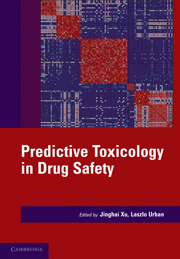Book contents
- Frontmatter
- Contents
- Contributors
- Prologue – Predictive toxicology: a new chapter in drug safety evaluation
- PREDICTIVE TOXICOLOGY IN DRUG SAFETY
- I SPECIFIC AREAS OF PREDICTIVE TOXICOLOGY
- 1 The human predictive value of combined animal toxicity testing: current state and emerging approaches
- 2 Screening approaches for genetic toxicity
- 3 Cardiac safety
- 4 Predicting drug-induced liver injury: safer patients or safer drugs?
- 5 In vitro evaluation of metabolic drug–drug interactions
- 6 Reliability of reactive metabolite and covalent binding assessments in prediction of idiosyncratic drug toxicity
- 7 Immunotoxicity: technologies for predicting immune stimulation, a focus on nucleic acids and haptens
- 8 Predictive models for neurotoxicity assessment
- 9 De-risking developmental toxicity-mediated drug attrition in the pharmaceutical industry
- II INTEGRATED APPROACHES OF PREDICTIVE TOXICOLOGY
- Epilogue
- Index
- Plate section
- References
5 - In vitro evaluation of metabolic drug–drug interactions
from I - SPECIFIC AREAS OF PREDICTIVE TOXICOLOGY
Published online by Cambridge University Press: 06 December 2010
- Frontmatter
- Contents
- Contributors
- Prologue – Predictive toxicology: a new chapter in drug safety evaluation
- PREDICTIVE TOXICOLOGY IN DRUG SAFETY
- I SPECIFIC AREAS OF PREDICTIVE TOXICOLOGY
- 1 The human predictive value of combined animal toxicity testing: current state and emerging approaches
- 2 Screening approaches for genetic toxicity
- 3 Cardiac safety
- 4 Predicting drug-induced liver injury: safer patients or safer drugs?
- 5 In vitro evaluation of metabolic drug–drug interactions
- 6 Reliability of reactive metabolite and covalent binding assessments in prediction of idiosyncratic drug toxicity
- 7 Immunotoxicity: technologies for predicting immune stimulation, a focus on nucleic acids and haptens
- 8 Predictive models for neurotoxicity assessment
- 9 De-risking developmental toxicity-mediated drug attrition in the pharmaceutical industry
- II INTEGRATED APPROACHES OF PREDICTIVE TOXICOLOGY
- Epilogue
- Index
- Plate section
- References
Summary
INTRODUCTION
Simultaneous coadministration of multiple drugs to a patient is a highly probable event. A patient may be coadministered multiple drugs for the treatment of a single disease (e.g., cancer, HIV infection) or for the treatment of multiple diseases or disease symptoms (e.g., type 2 diabetes, cholesterol elevation, high blood pressure). It is now known that drug–drug interactions may have serious, sometimes fatal consequences. Serious drug–drug interactions have led to the necessity of a drug manufacturer to withdraw or limit the use of marketed drugs. Examples of fatal drug–drug interactions are shown in Table 5.1. As illustrated by the examples in Table 5.1, a major mechanism of adverse drug–drug interactions is the inhibition of the metabolism of a drug by a coadministered drug, thereby elevating the systemic burden of the affected drug to a toxic level.
Besides toxicity, loss of efficacy can also result from drug–drug interactions. In this case, the metabolic clearance of a drug is accelerated due to the inducing effects of a coadministered drug on drug metabolism. A well-known example is the occurrence of breakthrough bleeding and contraceptive failures of women taking oral contraceptives who were coadministered with the enzyme inducer rifampin. Examples of drug–drug interactions leading to the loss of efficacy are shown in Table 5.2.
Estimation of drug–drug interaction potential is therefore an essential element of drug development. Screening for drug–drug interaction in early phases of drug development allows the avoidance of the development of drug candidates with high potential for adverse drug interactions.
- Type
- Chapter
- Information
- Predictive Toxicology in Drug Safety , pp. 76 - 101Publisher: Cambridge University PressPrint publication year: 2010



